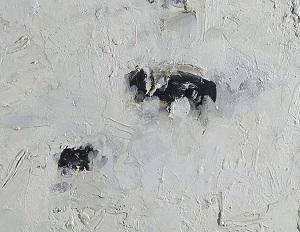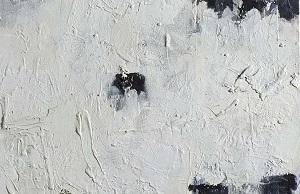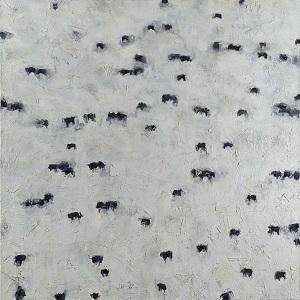Students explore what is meant by warm and cool colors and apply what they learn to Theodore Waddell’s Motherwell’s Angus. They will also explore the idea that snow is really white, but in the painting, Waddell uses different colors to create the snow. They will then experiment with cool color paint to see what different types of feelings they can create with color and share what they discover in small groups.
Students will be able to:
- describe what is meant by warm and cool colors;
- list at least five visual details in the painting;
- identify different colors used in the painting;
- feel comfortable taking creative risks to experiment with different colors of paint; and
- discuss the impact of their paintings with peers.
Lesson
- Preparation: Read the About the Art section on Motherwell’s Angus, in particular the “Details” section. The following article has information that can help you prepare to discuss the color combinations Waddell uses to paint snow: "Snow White, Maybe or Maybe Not". Set up the painting materials, making sure to cover tables or easels as needed.
- Warm-up: Show students examples of warm colors, such as red, yellow, and orange. Distribute paint sample cards and invite students to sort through and pull out warm colors. Ask them to share with a partner what they think of and feel when they see those colors. Repeat the process with cool colors such as blue, purple, and green. Lead a short discussion on why colors might make them feel different things.
- Show students Motherwell’s Angus. Tell students that “in a minute, but not yet,” you are going to have them hold up a finger for every color they see in the painting, and after you will call on them to tell you the colors. Have the students look at the painting closely for one minute and count the colors they see in their heads. After a minute, have them hold up their fingers and randomly select students to call out one color each. Write the colors they see on the board.
- As a class, have the students label each color “warm” or “cool.” Have them to talk with a partner about whether the painting feels warm or cool overall. Call on volunteers to share their ideas and lead a discussion about the overall feel of the painting.
- Ask students if they know what the word contrast means. Make sure everyone understands the definition of contrast and explain how warm and cool colors contrast with each other. You may want to use a color wheel to show how warm colors sit on one side of the wheel and cool colors sit on the opposite side.
- Ask students how Waddell used color to show contrast in his painting. For example, look at the contrast between the snow and the cows. Zoom in on the painting or hand out copied images. Ask the students what colors they see when the painting is enlarged. Why does the color combination used by Waddell give the effect of white snow?
- Review your class rules for painting. Give students time to paint fields of color with the blue, purple, black, and white paint you’ve prepared. Encourage them to mix colors and create different contrasting combinations. The goal is to evoke different types of feelings using various shades and combinations of colors.
- Ask students to share one of their “experiments” in groups of 3-4 and explain what feeling they think the color combination evokes.
- End the lesson by telling students that artists carefully choose the colors they use when making art, just as Waddell did with Motherwell’s Angus, and encourage them to experiment further with colors they use in their own art.
- Allow time for the students to clean up the materials and wash their hands.
Materials
- Paper on which each student can paint
- Blue, purple, black, and white paint
- Paint sample cards of various warm and cool colors
- Color wheel
- Paintbrushes, cups of water, and paper towels for drying brushes
- About the Art section on the Motherwell’s Angus
- Color copies of the Motherwell’s Angus for students to share, or the ability to project the image onto a wall or screen
Standards
- Visual Arts
- Invent and Discover to Create
- Observe and Learn to Comprehend
- Relate and Connect to Transfer
- Envision and Critique to Reflect
- Invention
- Self-Direction
Motherwell's Angus
- Theodore Waddell, American, 1941-
- Born: Montana
Theodore Waddell is a third-generation Montanan who has deep roots in both the West and American art. His pioneer grandmother moved west in a covered wagon, and his grandfather was an acquaintance of notable western artist Charles Russell. Born in Billings, Montana, Waddell grew up in Laurel, a small railroad town on the Northern Pacific line about 15 miles west of his birthplace. His father painted railroad boxcars and enjoyed working on paint-by-numbers during his time off. One of Waddell’s earliest memories is the smell of oil paint on his father’s clothes, and his love of the medium continues today.
Although Waddell set off for Eastern Montana College (now Montana State University-Billings) with an interest in architecture, he flunked a math test which derailed his plan of study. Instead, he enrolled in a studio art class offered by western landscape artist Isabelle Johnson, a decision that he cites as one of the most important and influential of his career. Within a month of meeting Johnson, Waddell decided, “I didn’t want to be alive and not make art.”
Waddell spent a year in New York City in the early 1960s, attending art classes at the Brooklyn Museum Art School and immersing himself in the work of abstract expressionism that artists like Jackson Pollock, Robert Motherwell, and Clyfford Still had developed in the 1950s. The energetic splashes, drips, and fields of oil paint on their canvases added to his lifelong love of the medium.
Despite the excitement of New York, home beckoned, and Waddell returned west to complete his degrees in studio art and education. He taught for several years at the University of Montana, and from 1976 to 1996, he settled down as a rancher, making art alongside his ranching duties. He would rise out of bed at 3:30 a.m. and paint until 8:00 a.m., when his ranch work began. During the winter—calving season—he would check on the cows at 2:00 a.m. and stay up to paint!
Waddell feels a strong connection to his home, saying that “Montana has caused me to be who I am, and I love this place,” and “I have to be where I am to paint what I paint.” He also loves animals and has spent decades of his life surrounded by cattle, sheep, horses, dogs, and other furry friends. He sees the animals and landscapes that he paints as inextricably connected; the cattle “give a focus to the landscape that can’t be perceived any other way.”
Winter is one of Waddell’s favorite times to paint. In winter, the landscape changes quickly and the snow reflects colors of light that are rarely found naturally in other seasons. Waddell also recalls that winter was one of his most productive artistic seasons when he was a rancher. Though he did need to check on his livestock, his fields required less attention during winter, giving him more time to paint.
Waddell often titles his paintings in honor of artists who have inspired him. While living and studying in New York City in the early 1960s, abstract expressionist artist Robert Motherwell was Waddell’s “all-time favorite.” Waddell was drawn to the flattened surface, textured application of paint, and abstracted forms of Motherwell’s canvases. Waddell completed a total of 25 paintings of cows in homage to the artist. This canvas is #6 of the series. Other homages to artists include Monet’s Sheep and Vincent’s Angus (after Vincent van Gogh).
Details

Dark Spots
At first glance, the dark blotches of paint scattered across the canvas might not look like any recognizable form or figure. A closer look reveals the legs, heads, and torsos of cows emerging from and disappearing into the painted landscape. Waddell wasn’t interested in depicting individual animals—none of the cows have specific features, nor are they painted with any detail. Rather, he was interested in painting the impression of a cow.

Cool Colors
Waddell applied white, light blue, and lavender paint to the canvas to create the feeling and appearance of a cold winter landscape. These cool colors bleed into one another throughout the work and are visible up close.

Endless Landscape
The cold winter landscape covers the entire surface of the canvas. Without any horizon line or use of perspective, the winter prairie stretches as far as the eye can see. The expansive view also comes from a lack of a focal point, which encourages the eye to roam across the picture plane. The cows are scattered about asymmetrically, at times even coming to the edge of the canvas.

Blending of Paint
From afar, the black paint of the cows contrasts sharply with the white and pastel-colored paint that makes up the winter landscape. Up close, however, the black paint blends into the lighter colors with subtler gradations. This painting technique adds to the snowy, hazy feel of the image.

Thick Paint
Waddell uses masonry trowels and specially modified brushes originally intended to apply tar to roofs to create a heavy build-up of paint on the surface of the canvas. Some areas of paint are so thick that the texture looks like frosting!
Waddell feels that “there’s a magic to oil paint that is unsurpassed by any other medium or activity. The notion of loading a brush with a big dollop of paint is about as good as it gets. The sensation of developing a line or shape with this material is wonderful.”

Large Square
Motherwell’s Angus measures six feet square. Waddell likes to paint his works on large canvases, giving him plenty of room to play with his paints, and suggesting the vastness of the Montana landscape.
Funding for object education resources provided by a grant from the Morgridge Family Foundation. Additional funding provided by the William Randolph Hearst Endowment for Education Programs, and Xcel Energy Foundation. We thank our colleagues at the University of Denver Morgridge College of Education.
The images on this page are intended for classroom use only and may not be reproduced for other reasons without the permission of the Denver Art Museum. This object may not currently be on display at the museum.







